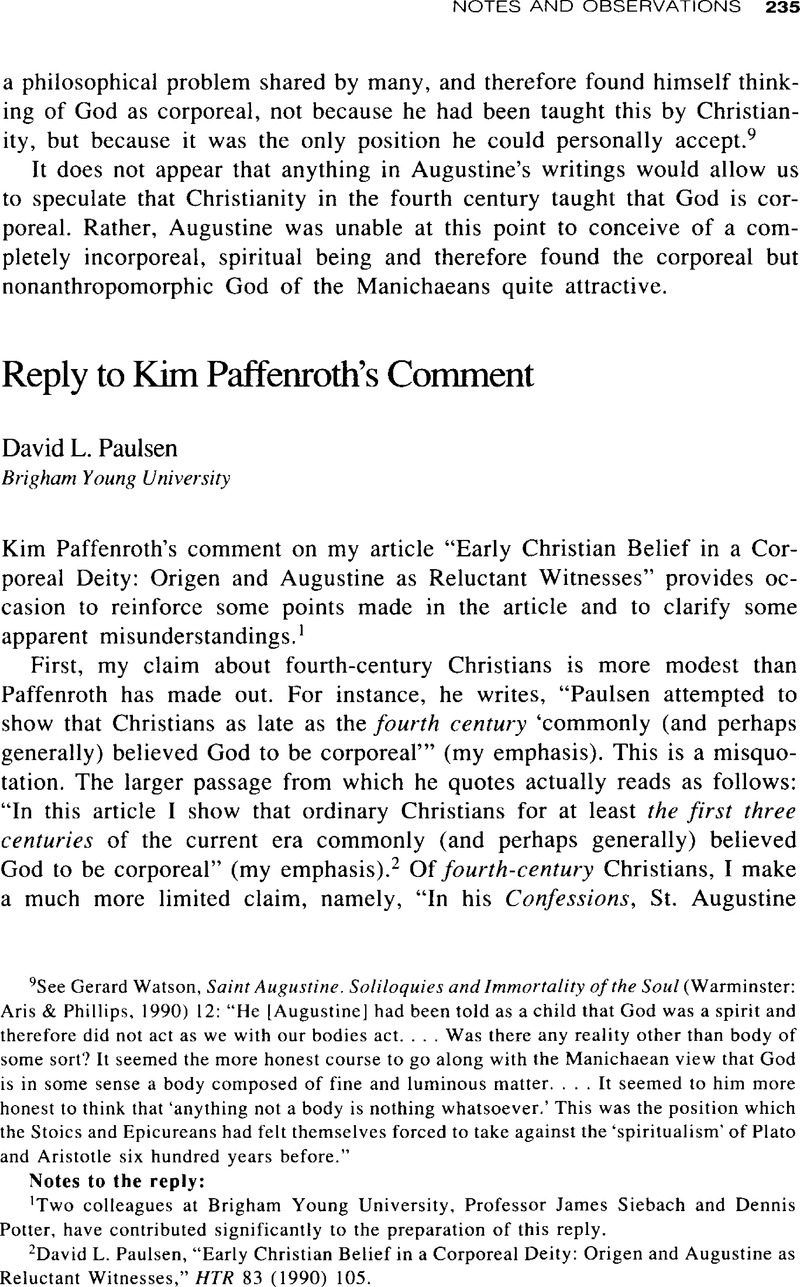Published online by Cambridge University Press: 10 June 2011

Notes to the reply:
1 Two colleagues at Brigham Young University, Professor James Siebach and Dennis Potter, have contributed significantly to the preparation of this reply.
2 Paulsen, David L., “Early Christian Belief in a Corporeal Deity: Origen and Augustine as Reluctant Witnesses,” HTR 83 (1990) 105CrossRefGoogle Scholar.
3 Ibid., 114.
4 See Muller, Liguori G., The De Haeresibus of Saint Augustine: A Translation With An Introduction and Commentary (Washington, DC: Catholic University of America Press, 1956)Google Scholar. Muller says (p. 50), “It becomes evident immediately in the De haeresibus that Augustine envisioned a heresy as a concrete sect, not a heretical proposition, since he speaks of the individual members of the sect rather than of the tenets they hold.”
5 Augustine apparently thought there was only one group, identifying the Audiani with the Egyptian anthropomorphites. See ibid., 178 n. 7.
6 Meinardus, Otto (Monks and Monasteries of the Egyptian Deserts [rev. ed.; Cairo: American University in Cairo Press, 1989] 53Google Scholar) asserts that “the anthropomorphite heresy was so widespread that the anthropomorphists appear to have outnumbered the liberal party [the Origenists who preferred allegorical to literal interpretations of the scriptures] by at least three to one.”
7 Cassian, JohnConferences (trans. Luibheid, Colm; Classics of Western Spirituality; New York: Paulist, 1985)Google Scholar 10.2 (pp. 125–26). “See Paulsen, “Corporeal Deity,” n. 41 and accompanying text.
9 Cassian Conferences, 10.3 (pp. 126–27). In his biography of Cassian, Owen Chadwick claims that Cassian downplays the resoluteness of Egyptian resistance to Theophilus's condemnation of anthropomorphism. He says (John Cassian [2d ed.; Cambridge: Cambridge University Press, 1968] 28–29Google Scholar), “The consequent events we can trace, though obscurely, in Sozomen, Socrates, Palladius and the letters of Jerome. Were Cassian the sole authority, the impression would be left that, despite the fierce opposition of great numbers, the decrees of Theophilus were ultimately accepted by the Egyptians. We hear nothing in Cassian of the riots in Alexandria, of the bishop's submission, of the explusion of Origenism.”
10 Paulsen, “Corporeal Deity,” 114.
11 According to Augustine's own account, the scriptural warrant for Christian belief in divine embodiment was largely found in the Hebrew Bible and hence was not based upon the Incarnation. For instance, in the Confessions, Augustine reveals that it was only after he met Ambrose in Milan that he understood that “the text concerning man being made by you in your image (Gen 1:26) not to mean that they [Christian Neoplatonists] believed and thought you to be bounded by the form of a human body” (Augustine Confessions 6.3.4; see also 5.14.24). In addition, Augustine wrote Epistula 148 (see above p. 238) to prevent a fellow bishop from taking literally passages where prophets from the Hebrew Bible report face-to-face encounters with God. See Gen 32:30 (“I have seen God face to face”); Exod 33:11 (“the Lord used to speak to Moses face to face”); see also 1 Cor 13:12. Finally, the Christian anthropomorphites to whom Augustine refers in Contra epistolam quam vocant fundamenti (see above) find their scriptural warrant not in accounts of the Incarnation, but in scriptural references to the parts of God's body–eyes, ears, and so forth.